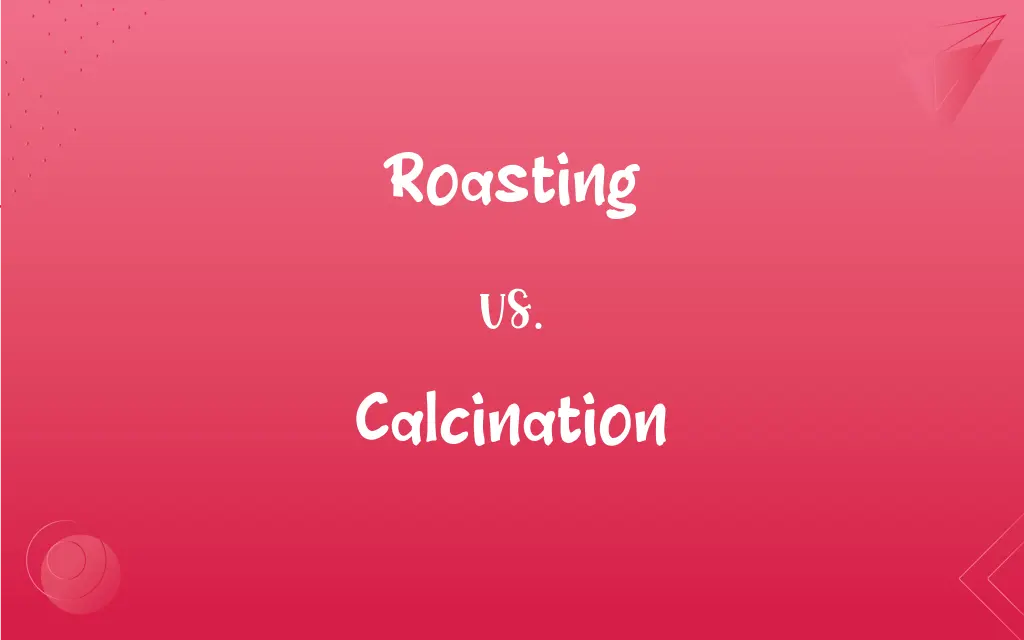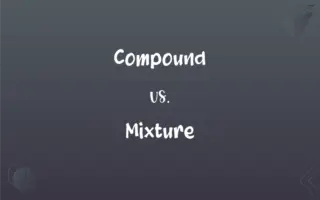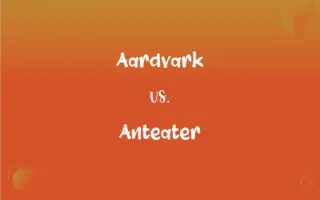Roasting vs. Calcination: What's the Difference?
Edited by Aimie Carlson || By Harlon Moss || Updated on October 17, 2023
Roasting involves heating ores to bring about a chemical change, often to oxidize sulfides. Calcination heats substances in the absence of air, mostly to remove volatile substances.

Key Differences
Roasting is a metallurgical process that involves the heating of an ore, typically in the presence of air, to initiate a chemical change. In contrast, calcination is the process of heating a substance to a high temperature but in the absence of air or oxygen.
During roasting, the main aim is often to oxidize sulfides to produce oxides. On the other hand, calcination primarily focuses on driving off volatile substances like water or carbon dioxide, or to cause thermal decomposition.
The resultant products of roasting are usually more suitable for further processing or refining due to the removal or conversion of impurities. Meanwhile, calcination often results in anhydrous or oxide forms of materials, making them more reactive for industrial uses.
Roasting is often applied to sulfide ores to remove impurities like sulfur in the form of sulfur dioxide gas. Calcination, however, frequently targets carbonate ores and other materials to drive off carbon dioxide.
In sum, while both roasting and calcination are thermal processes aiming at modifying the state or properties of materials, the former usually involves oxidation while the latter involves removal of volatiles or thermal decomposition.
ADVERTISEMENT
Comparison Chart
Aim
Chemical change, often oxidation
Removal of volatile substances
Presence of Air
Typically in the presence of air
Absence of air or oxygen
Commonly Treated Ores
Sulfide ores
Carbonate ores
Key Removal
Impurities like sulfur
Volatiles like water or CO2
Resultant Form
More refined or oxidized ores
Anhydrous or oxide forms
ADVERTISEMENT
Roasting and Calcination Definitions
Roasting
A metallurgical process that involves the heating of ores to initiate a chemical change.
The ore underwent roasting to remove the sulfur impurities.
Calcination
A thermal treatment method to cause decomposition or removal of volatile components.
The removal of water from gypsum via calcination produces plaster of Paris.
Roasting
A thermal process used to achieve the decomposition of certain materials.
The sulfide content was reduced through roasting, improving the ore's quality.
Calcination
The technique of heating materials under controlled conditions to alter their physical or chemical properties.
The pottery was treated with calcination to improve its strength and durability.
Roasting
A heat treatment process to oxidize certain elements in an ore.
To obtain pure metal, the sulfide ore required roasting.
Calcination
The process of heating substances in the absence of air to drive off volatiles.
Limestone undergoes calcination to produce quicklime.
Roasting
The conversion of sulfide ores to oxides by heating in air.
Roasting is a crucial step in refining certain types of ores.
Calcination
The act of heating a substance to a high temperature without melting it, causing a state change.
Through calcination, the carbonate ore was transformed into its oxide.
Roasting
The act of exposing ores to high temperatures in the presence of air to effect oxidation.
Roasting the mineral led to the extraction of the desired metal.
Calcination
A method applied to ores and other solid materials to bring about a thermal decomposition.
Calcination of the clay resulted in the production of alumina.
Roasting
To cook with dry heat, as in an oven or near hot coals.
Calcination
To heat (a substance) to a high temperature but below the melting or fusing point, causing loss of moisture or volatile impurities, reduction or oxidation, and the decomposition of carbonates and other compounds.
Roasting
To dry, brown, or parch by exposing to heat.
Calcination
To convert (liquid material, especially radioactive wastes) to granular solids by drying at very high temperatures.
FAQs
What's a primary outcome of calcination?
Calcination typically produces anhydrous or oxide forms of materials.
How does calcination differ from roasting?
Calcination involves heating substances, often in the absence of air, to drive off volatile components or cause decomposition.
What happens to limestone during calcination?
Limestone, when subjected to calcination, decomposes to produce quicklime and carbon dioxide.
Why is roasting necessary?
Roasting helps to remove or convert impurities in ores, making them suitable for further processing.
What gas is often released in roasting sulfide ores?
Roasting sulfide ores usually releases sulfur dioxide gas.
What is roasting?
Roasting is the process of heating ores, usually in the presence of air, to bring about a chemical change, often oxidation.
Are both roasting and calcination applied to ores?
Yes, both are thermal treatments for ores, but roasting often targets sulfide ores while calcination targets carbonate ores.
Can roasting be used for materials beyond ores?
While primarily for ores, roasting can treat other sulfide-containing materials.
Is calcination a type of drying process?
Not exactly. While calcination can remove moisture, its main goal is the thermal decomposition or removal of volatiles.
Does roasting always lead to oxidation?
Mostly yes, as roasting in the presence of air typically results in oxidation.
Which process is more energy-intensive?
The energy requirement varies based on the material and desired outcome, but generally, both processes demand significant heat.
Are both processes carried out at high temperatures?
Yes, both roasting and calcination involve exposing materials to high temperatures.
Why is the presence or absence of air crucial in these processes?
Roasting requires air for oxidation, while calcination, done in the absence of air, prevents unwanted oxidation.
Can calcination result in a change of physical state?
Yes, calcination can transform a material's state, such as turning a carbonate into its oxide.
Which process is typically applied first when refining ores?
Depending on the ore, roasting is often the initial step, followed by other refining processes.
How do roasting and calcination affect the environment?
Both can release gases. Roasting may emit sulfur dioxide, while calcination can release carbon dioxide.
Do both processes alter the chemical composition of the material?
Yes, both roasting and calcination aim to change the chemical or physical state of materials.
Is roasting always done in open air?
Not necessarily. Roasting can be done in special roasting furnaces or reactors to control conditions.
Is calcination used in pottery?
Yes, calcination can treat certain clays in pottery to improve their properties.
Can roasting and calcination be used for other materials beyond ores?
Yes, while commonly used for ores, they can treat other materials like limestone in calcination.
About Author
Written by
Harlon MossHarlon is a seasoned quality moderator and accomplished content writer for Difference Wiki. An alumnus of the prestigious University of California, he earned his degree in Computer Science. Leveraging his academic background, Harlon brings a meticulous and informed perspective to his work, ensuring content accuracy and excellence.
Edited by
Aimie CarlsonAimie Carlson, holding a master's degree in English literature, is a fervent English language enthusiast. She lends her writing talents to Difference Wiki, a prominent website that specializes in comparisons, offering readers insightful analyses that both captivate and inform.
































































